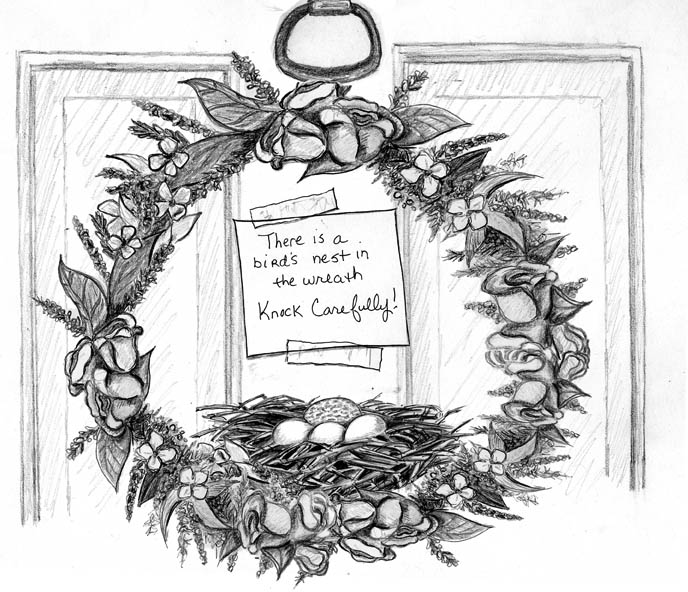
Dear Bird Folks,
Please watch the attached video. It shows a bird’s nest in a wreath on the front door of my friend Jessica’s aunt’s house, and the nest is filled with eggs. She found the nest on Mother’s Day. Pretty cute, eh?
– Sandy, Wilmington, NC
It’s cute all right, Sandy,
The cute part of the video is the note written on your friend Jessica’s aunt’s door saying: “There’s a nest in the wreath. Knock carefully!” I’m sure that note will bring smiles to the faces of her next visitors, and the pizza delivery guy and any Jehovah’s Witnesses who may be roving around the neighborhood. However, the contents of the nest itself are less cute. In the nest I see four light blue House Finch eggs, plus one larger egg that is heavily covered in brown streaks. That larger egg belongs to a female Brown-headed Cowbird. And even though the nest was discovered on Mother’s Day, cowbirds are not very good mothers. In fact, only Joan Crawford has more notorious parenting skills than a mother cowbird has. (Ask Jessica’s aunt who Joan Crawford was.)
Many regular readers of this column are likely to be familiar with the cowbird’s bizzare reproductive methods. But judging from your confused look when I told you about the cowbird, Sandy, I can tell this topic is all new to you. So, in order to get you, and Jessica and perhaps her aunt up to speed, here’s a quick rundown of the cowbird’s parenting habits. The cowbird is refered to as a “brood paristite.” Instead of building her own nest, and incubating her own eggs and feeding her own chicks, the female cowbird has figured out a way to get another bird to do all of those domestic chores for her. How does she do it? Like a human bird watcher, a female cowbird spends the day patiently watching other birds. If she sees a bird carrying nesting material, she will secretly follow it. Then, when the nesting bird isn’t looking, the cowbird will swoop down, lay one of her eggs in the nest, fly off and never look back. This is not normal motherly behavior…even by Joan Crawford standards.
What’s so bad about that, you ask? A lot of parents would love to have someone else raise their kids for them. But with cowbirds there’s a big downside. Cowbird babies hatch out earlier and eat more food than the host’s own nestlings do. As a result, the original babies might get squeezed out and ultimately may not survive. The next question is, why do parents put up with this nonsense? Why don’t they just toss the foreign egg out of their nest? Actually, some bird do just that, while others simply abandon the nest and start over someplace else. Other birds are even more creative. Yellow Warblers, for example, are too small to remove the larger cowbird egg, but they are also too lazy to find a new nest site. Instead, they build a second floor in their nest, sealing the cowbird’s egg in the “basement.” Other birds are kind of clueless and simply don’t notice any difference. They happily hatch and raise the cowbird chick as if it were their own. This can create quite a spectacle. Typically, the host birds are significantly smaller than the fast-growing cowbird chick. Seeing a “baby” bird feeding a larger bird freaks out a lot of people, and with good reason. But don’t worry about your House Finch family. When it comes to dealing with cowbirds, they have the most devious plan of all…and they don’t even know it.
In order to help them grow faster, most baby songbirds receive a steady diet of protein-rich insects. However, the health conscious and envronmentally concerned House Finches are vegetarians. They don’t want to eat bugs anymore than the rest of us do. The all-veggie diet doesn’t bother finch chicks, but the little cowbird isn’t so lucky. Without juicy insects on the menu, its growth becomes stunted and more often than not it never grows up. Right now, Sandy, you are thinking: “What can we do to help the baby cowbird? Should we feed it something?” (I know that is what you are thinking, because that’s what you asked me when I initially explained the situation to you. I believe your exact question was: “Can I give it some ham?” Ham?) This is a tricky one, but basically the answer is no. When it comes to helping our native songbirds, Joe (or Josephine) Q. Public is allowed to set up birdfeeders, put out water and erect birdhouses, and that’s about it. Without proper permits we are not allowed to directly feed baby birds, remove unwanted eggs or interfere with nests in any way… except to post a sign that reads: “Knock carefully!”
My advice, Sandy, is to tell your friend Jessica to tell her aunt to sit back and watch the show. As their name implies, House Finches like to be near our homes, and thus will tolerate a moderate amount of human interaction. Occasionally checking their nest won’t cause any problems. Also, Brown-headed Cowbirds and House Finches are both extremely common birds. As weird as it may seem, their peculiar breeding methods have worked for a long time and they don’t need any meddling from us. Just keep me posted on how things turn out. In the meantime, I have to go to work and stock my bird food department. I seem to be missing one important item…ham.